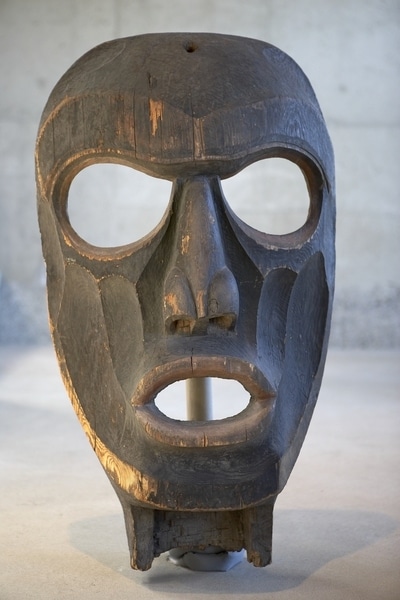Feast Dish Lid Item Number: A4342 from the MOA: University of British Columbia


Description
Large wooden mask-like shaped lid carved in the form of Dzunuk'wa (Tsonoqua). She has large open mouth and eyes, pursed lips, shallow cheeks and carved nose. Painted red around the eyes and the mouth; face painted black.
History Of Use
Used as a feast dish lid. The carvings used were usually mythical beings associated with the history of the family who had the right to use representations of them as family crests. Dramatic displays of rank and privilege have traditionally been part of the oratory, dancing, regalia, and feasting that accompany the Kwakwaka’wakw potlatch. Immense feast dishes representing Dzunuk̓wa, or Wild Woman, were used at events where the host would challenge his rivals to promise future feasts. The placement of the dish, and the manner in which chiefs were served from its various parts, would reflect the rank of each tribe and sometimes fuel rivalries among them.
Cultural Context
ceremony; status
Iconographic Meaning
Dzunuk'wa (Tsonoqua) is usually recognized by her blackened face, sunken eyes and cheeks, and pursed lips. Tsonoqua was a female giantess who inhabited the distant forest and mountains. She had a distinctive cry 'hu, hu' and was particularly threatening to children. She could also be benevolent in some aspects. Used as a crest she was associated with wealth and power.
Narrative
This lid appears in a historical photo, taken c. 1926, of fourteen men at Kingcome Inlet village, posing with three Dzunukwa feast dish lids (one of which is attached to a huge dish). One of the other lids in the photo appears to be MOA #A2522. The men have been identified as: Bill Wilson, Sam Webber, Chief Iwakalas (Jim Humchitt), Tommy King, Alec Willie, Mr. Williams, Head Chief Kodalagalis (Dick Webber), Harry Jack, Alfred Coon, William Webber, William Dawson, Jim King, Albert Dawson, and Shorty James.
Item History
- Made in British Columbia, Canada before 1926
- Collected in Kingcome Inlet, British Columbia, Canada and Ukwanalis, British Columbia, Canada during 1953
- Owned by Tom Patch Wamiss before May 1953
- Received from H. R. MacMillan (Funding source) and Tom Patch Wamiss (Seller) during May 1953
What
Who
- Culture
- Kwakwaka'wakw
- Previous Owner
- Tom Patch Wamiss
- Received from
- H. R. MacMillan (Funding source) and Tom Patch Wamiss (Seller)
Where
- Holding Institution
- MOA: University of British Columbia
- Made in
- British Columbia, Canada
- Collected in
- Kingcome Inlet, British Columbia, Canada and Ukwanalis, British Columbia, Canada
When
- Creation Date
- before 1926
- Collection Date
- during 1953
- Ownership Date
- before May 1953
- Acquisition Date
- during May 1953
Other
- Condition
- fair
- Accession Number
- 1895/0001